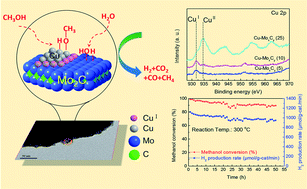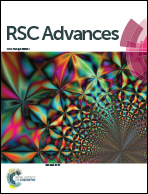Highly-efficient steam reforming of methanol over copper modified molybdenum carbide
Abstract
Cu doped molybdenum carbide (Cu–MoxCy) catalysts were prepared by carburization of Cu doped molybdenum oxide (Cu–MoO3) using a temperature-programmed reaction with a 20% CH4–H2 mixture at 700 °C. Phase transition of the prepared molybdenum carbide was found to be related to the doping amount of Cu: with the increase in the doping amount of Cu/Mo molar ratio of 1.6/98.4 to 10/90, the cubic α-MoC1−x phase increased in the catalyst, but with the continued increase of the doping amount to a Cu/Mo molar ratio of 15/85, the α-MoC1−x phase began to decrease, and when the Cu doping amount reached a Cu/Mo molar ratio of 25/75, the α-MoC1−x phase became very weak and mainly hexagonal β-Mo2C phase was found in the catalysts. TEM images indicated that carbon growth on the surface of Cu occurred during the carburization process in the case of high Cu doping. Steam reforming of methanol (SRM) over the Cu–MoxCy catalyst was investigated at a temperature range of 200–400 °C. It is found that Cu–MoxCy catalyst with Cu/Mo molar ratios in the range of 1.6/98.4–10/90 showed high catalytic activity as well as long-term stability. X-ray photoelectron spectroscopy analysis indicated the coexistence of CuI and CuII species on the surface of the molybdenum carbide. The existence of CuI could result in high activity for methanol conversion and high stability, which might result from the strong interaction between Cu and Mo2C support.


 Please wait while we load your content...
Please wait while we load your content...